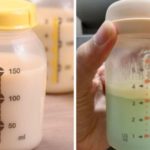Engorgement and milk duct blockage are two distinct postpartum conditions that, if not properly identified, can have adverse effects on a mother’s health. To learn more about these conditions and how to differentiate between them, read on.
1 What is Physiological Breast Engorgement?
Breast engorgement is a common occurrence in postpartum mothers. This condition typically arises 2-7 days after childbirth, during which the mother experiences pain, a burning sensation, and breast engorgement, resulting in minimal milk secretion.
 What is breast engorgement?
What is breast engorgement?
Breast engorgement in postpartum mothers occurs due to insufficient oxytocin release, leading to a lack of milk release from the alveoli and subsequent breast engorgement.
2 What is Milk Duct Blockage?
 What is milk duct blockage?
What is milk duct blockage?
Milk duct blockage occurs when a mother’s body produces more milk than her infant can consume. This can be attributed to various factors, such as incomplete milk expression after breastfeeding, delayed feeding, or ineffective latching by the baby.
Additionally, narrow milk ducts or a diet high in animal fat, which can lead to milk duct blockage, are also contributing factors.
3 Differences Between Breast Engorgement and Milk Duct Blockage
To understand the distinctions between breast engorgement and milk duct blockage, refer to the following comparison table:
| Breast Engorgement | Milk Duct Blockage |
| Occurs 2-7 days after childbirth | Does not occur immediately after childbirth |
| Breast engorgement | Breast pain |
| Milk continues to flow abundantly | No lymph node involvement |
| Breast pain | Milk flow is reduced or absent |
| Mild or no fever | Mild to moderate fever |
| Lymph nodes in the armpits are enlarged | Hard lumps in the breast |
 Differences between breast engorgement and milk duct blockage
Differences between breast engorgement and milk duct blockage
4 Management of Breast Engorgement and Milk Duct Blockage
Managing Physiological Breast Engorgement
 Managing physiological breast engorgement
Managing physiological breast engorgement
There are several approaches to managing breast engorgement in postpartum mothers. Some recommended measures include:
- Cold compress: Apply a cold compress to both breasts to alleviate pain, swelling, and engorgement during breastfeeding or pumping.
- Frequent breastfeeding: Breastfeed your baby regularly to stimulate milk production and release, preventing breast engorgement.
- Use a breast pump: If milk is not adequately released, use a breast pump to express milk and ease breast engorgement.
Managing Milk Duct Blockage
 Managing milk duct blockage
Managing milk duct blockage
To address milk duct blockage, mothers should consider the following:
- Initiate breastfeeding within the first hour after childbirth to ensure proper latching and positioning of the baby.
- If milk duct blockage occurs during breastfeeding, experiment with different feeding positions to find the most comfortable and effective one for your baby.
- Wear a specialized nursing bra that provides adequate support without being too tight, as this can contribute to milk duct blockage.
- Apply warm compresses or take warm showers before breastfeeding to encourage milk flow.
- If the breasts become swollen, use cold compresses to reduce inflammation.
- If the baby is unable to breastfeed, express milk manually or with a pump.
Breast engorgement and milk duct blockage are common issues faced by breastfeeding mothers. It is essential to distinguish between these two conditions and take timely and appropriate measures to prevent any potential complications. Therefore, understanding the differences between physiological breast engorgement and milk duct blockage is crucial.
Source: Vinmec.com
Mothers’ Need for Awareness of Dual Activity of Breastfeeding and Watching TV
In the contemporary world, in which technology pervades our lives, some mothers tend to soothe their babies through nursing while simultaneously watching television. Although this practice may not appear to affect the infant, studies show that it can in fact have dire repercussions on the baby’s well-being, both in terms of physical health and mental growth. In this article, we will look at the possible reasons for this activity and its potential outcomes.






































